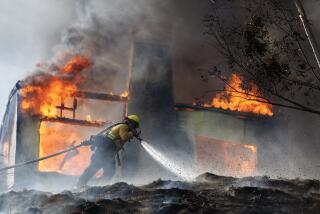Fire Reopens Debate on Sprinklers
A Los Angeles councilman said Tuesday he would propose an ordinance that would close a gap in the city’s fire codes that allows an estimated 75% of high-rise residential buildings to go without fire sprinklers, renewing a decades-long debate over the costly improvements.
Martin Ludlow, who represents the section of Koreatown where a high-rise fire Monday left one woman with critical burns, said he is aware such retrofitting would cost thousands of dollars per unit but said the city and property owners have a responsibility to protect residents.
“We’ve got to figure out what the middle ground is to make this safe,” he said. “You can’t put a dollar amount on human life.... It’s just got to send chills down your spine. We’ve got [people] living in these tall buildings, and we don’t have the kind of infrastructure that seems adequate.”
While several other council members expressed support for Ludlow’s idea, the plan has met with skepticism from apartment and condominium owners who 11 years ago killed a similar effort by the Fire Department to require sprinklers in all residential high-rise buildings.
“Who is against safety?” said Charles Isham, executive vice president of the Apartment Assn. of Los Angeles, which represents about 12,000 building owners in the city. “The problem is what do you do for people under rent control? You can’t force someone to expend money without allowing compensation.”
Isham said apartment owners would have no problem with the law -- provided the city could find a way to pay for it or allow the apartment owners to bill tenants for the improvements. As it stands, the apartment owners can’t pass the costs along because of the city’s rent-control laws.
Al Hernandez, the city’s assistant fire marshal, said building owners estimated in 1993 that it would cost up to $19,000 per unit to fit buildings with sprinklers, and that the price could be higher today. Tenants may have to be relocated while the work is being done.
The city’s experience with an ordinance requiring retrofits in 350 commercial high-rises lacking sprinkler systems hints at the difficulties a new residential plan could face. The ordinance was passed in 1988 after one person died in a downtown fire at the First Interstate Bank. But officials struggled to get property owners to comply. Three years after the ordinance passed, only 50% of the buildings had been retrofitted, and fire officials said the deadline for compliance had to be pushed back several times.
“There’s natural resistance,” said David Keim of the Los Angeles Department of Building and Safety. “We issue orders to comply, there’s an appeals process, sometimes [owners] will litigate these things in court. It delays the enforcement.”
Sixteen years after the commercial retrofit ordinance was passed, city officials said all the buildings now have sprinkler systems completed or “in the process.”
Fire officials have long believed that sprinklers significantly reduce the risk of death, injury and property damage.
“No matter what the occupancy, sprinklers are a must in high-rise buildings,” said Gary Keith, vice president of the National Fire Prevention Assn.
The fire on the sixth floor of the Wilshire Tower in Koreatown on Monday was one of several in residential high-rises not covered by sprinkler rules. In the early 1990s, there was a string of residential high-rise fires, including two that resulted in deaths in West L.A. and Century City.
After 24 people died in a fire at the Dorothy Mae apartment complex near downtown in 1982, the city required sprinkler installation in more than 1,300 apartment buildings constructed before 1943. But that left uncovered an estimated 150 buildings built after 1943 but before the state required sprinklers in all new construction in 1974.
Other cities have faced a similar debate over the costly sprinkler systems, and adopted a variety of approaches. Los Angeles sprinkler policies are behind some and ahead of others.
After Boston’s Prudential Tower fire in 1986, Massachusetts required all high-rise buildings to install sprinkler systems, and gave owners 10 years to complete the process, said Keith of the NSPA.
In New York, only residential buildings with four or more units constructed after 1999 were required to have sprinkler systems, though there were some exceptions, said Ilyse Fink, spokeswoman for the New York City Department of Buildings. Florida requires all high-rise buildings to retrofit for sprinkler systems as part of the engineered life safety plan that passed throughout the state in 1994, said Lt. Joe Gagliano of the Miami-Dade Fire Engineering and Water Supply Bureau.
Despite the hurdles the proposal faces, several council members say they are determined to take another crack at working out a solution.
“All buildings should be sprinklered,” said Councilman Tom LaBonge, who said he plans to support Ludlow’s motion. “I hope this will cause us to finally” put them in. Until Monday’s fire, LaBonge said, he had assumed all buildings already had sprinklers.
Added Councilman Jack Weiss: “When you meet the surviving relative of someone who died because of insufficient regulations, it reorients your priorities.”
More to Read
Sign up for Essential California
The most important California stories and recommendations in your inbox every morning.
You may occasionally receive promotional content from the Los Angeles Times.










